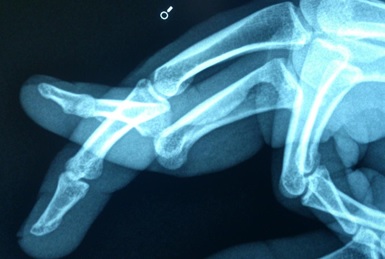How to treat a dislocated finger?

A dislocated finger occurs when a finger bone slips out of its joint. Sports injuries, falls, and accidents can cause a finger or thumb to dislocate.
Last reviewed
Dislocating a finger or thumb can be extremely painful and distressing. Although dislocation is not a life-threatening emergency, it is still important to seek prompt medical attention.
This article describes what to do when a person dislocates their finger or thumb. It also discusses the symptoms, causes, treatment, and recovery for a dislocated finger.
What to do
A person should not try to relocate a dislocated finger themselves.
Image credit: Mdumont01, 2013
People who suspect they have dislocated their finger should seek immediate medical attention. While waiting for help or heading to a clinic, it is important not to move the damaged finger or thumb. Applying ice to the finger may help to reduce pain and swelling.
Do not attempt to move the finger bone back into its joint; a qualified healthcare professional must do this. Trying to relocate the finger bone without proper training can make the injury worse and cause additional pain and swelling.
People who attempt to move their own finger bone back into place also risk permanently damaging the surrounding structures, such as:
- tendons
- ligaments
- nerves
- blood vessels
- joint articular cartilage
Symptoms
A dislocated finger may appear swollen or crooked and is typically very painful.
Other signs that indicate a dislocated finger include:
- numbness or tingling
- bruising or discoloration of the skin
- difficulty moving the injured finger
Causes
Fingers contain three joints, and thumbs contain two. A joint is where the ends of two bones meet. Ligaments are short bands of fibrous material that hold the bones together and help support the joint.
Dislocations can occur when a significant force causes the ligaments to give way, causing the bone to slip out of the joint.
Sports injuries are a common cause of dislocated fingers. According to a 2015 review, around half of all sports-related hand injuries affect the fingers. Sports with the highest rates of hand injuries include football, gymnastics, basketball, lacrosse, and wrestling.
Other possible causes of a dislocated finger can include:
- overextending the finger
- blunt force impact to the tip of the finger, or jamming
- falling on an outstretched arm
People with health conditions that can weaken joints and ligaments may be at greater risk of dislocations.
Diagnosis

A doctor may use an X-ray to confirm a dislocation or fracture.
A healthcare professional will examine the affected finger and ask the person about how and when the injury occurred. They may then order an imaging test to confirm a dislocation or evaluate the extent of damage to the finger.
Imaging tests for dislocated fingers include:
- X-ray. X-rays use electromagnetic radiation to create images of the body’s internal structures. Doctors use X-ray images to confirm dislocations and to check for fractures or breaks.
- MRI scan. An MRI scan uses strong magnetic fields and radio waves to create detailed images of the tissues inside the body. A doctor may recommend an MRI scan if they suspect significant tissue damage near the dislocated joint.
